Feb 10 2017
An innovative kind of LED arrays with the ability to both emit and detect light can enable cellphones and other devices to be controlled using touchless gestures and to charge themselves with the help of ambient light.
 A laser stylus writes on a small array of multifunction pixels made by dual-function LEDs than can both emit and respond to light. CREDIT: Photo courtesy of Moonsub Shim.
A laser stylus writes on a small array of multifunction pixels made by dual-function LEDs than can both emit and respond to light. CREDIT: Photo courtesy of Moonsub Shim.
The LEDs are fabricated using tiny nanorods that are arrayed in a thin film, and can offer multitasking devices and new interactive functions. The discovery has been reported by scientists from the University of Illinois at Urbana-Champaign and Dow Electronic Materials in Marlborough, Massachusetts, in the February 10th issue of Science.
“These LEDs are the beginning of enabling displays to do something completely different, moving well beyond just displaying information to be much more interactive devices,” stated Moonsub Shim, who headed the study and is a professor of materials science and engineering at the University of Illinois. “That can become the basis for new and interesting designs for a lot of electronics.”
The diameter of the tiny nanorods is less than 5 nm, and they are fabricated using three types of semiconductor material. While one semiconductor emits and absorbs visible light, the other two materials control the way in which charge flows through the first one. Such a combination enables the LEDs to emit, sense, as well as respond to light.
By rapidly switching between emitting and detecting modes, the nanorod LEDs carry out both functions. The shift is so rapid that the display seems to be constant to the human eye. As a matter of fact, three orders of magnitude of the display are faster than standard display refresh rates. Nevertheless, the LEDs detect and absorb light in a near-continuous manner, and their display can be programmed in such a way that it responds to light signals in several ways.
For instance, brightness of a display can be automatically adjusted in response to ambient light conditions, on a pixel-by-pixel basis.
You can imagine sitting outside with your tablet, reading. Your tablet will detect the brightness and adjust it for individual pixels. Where there’s a shadow falling across the screen it will be dimmer, and where it’s in the sun it will be brighter, so you can maintain steady contrast.
Shim
The research team demonstrated not only pixels that could automatically adjust brightness but also those that could respond to an approaching finger. This function can be integrated into interactive displays with the ability to respond to touchless gestures or to identify objects.
In addition, the researchers demonstrated arrays with the ability to respond to a laser stylus. This function can become the foundation of tablets, smart whiteboards, or other surfaces used for drawing or writing with light. Moreover, they discovered that apart from responding to light the LEDs could also convert light into electricity.
The way it responds to light is like a solar cell. So not only can we enhance interaction between users and devices or displays, now we can actually use the displays to harvest light. So imagine your cellphone just sitting there collecting the ambient light and charging. That’s a possibility without having to integrate separate solar cells. We still have a lot of development to do before a display can be completely self-powered, but we think that we can boost the power-harvesting properties without compromising LED performance, so that a significant amount of the display’s power is coming from the array itself.
Shim
Apart from interacting with users and their surrounding ambience, the nanorod LED displays have the ability to also interact with one another similar to large parallel communication arrays. Shim further stated that although the interactions are slower than device-to-device technologies such as Bluetooth, they are serial, i.e. they can send only one bit at a time. When two LED arrays face each other, they can communicate using the number of bits equal to the number of pixels in the screen.
We primarily interface with our electronic devices through their displays, and a display’s appeal resides in the user’s experience of viewing and manipulating information. The bidirectional capability of these new LED materials could enable devices to respond intelligently to external stimuli in new ways. The potential for touchless gesture control alone is intriguing, and we’re only scratching the surface of what could be possible.
After performing their demonstrations using arrays of red LEDs, the researchers are now concentrating on techniques of patterning three-color displays with blue, red, and green pixels. They are also working hard to boost the light-harvesting capacity by modifying the composition of the nanorods.
With the main goal of promoting industry-oriented technologies, this research was supported by a collaborative research effort between the University of Illinois and the Dow Chemical Company. The research was also supported by the National Science Foundation.